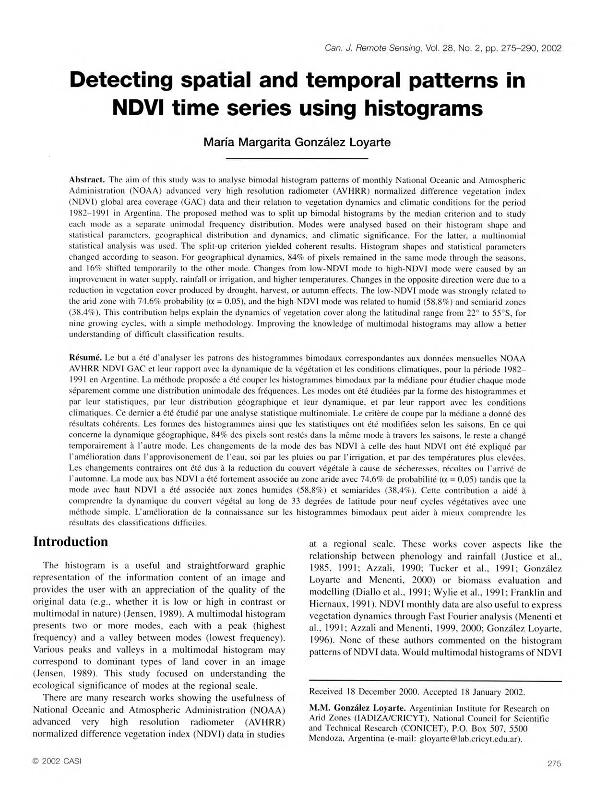Mostrar el registro sencillo del ítem
dc.contributor.author
Gonzalez Loyarte, Maria Margarita

dc.date.available
2022-11-09T20:21:48Z
dc.date.issued
2002-04
dc.identifier.citation
Gonzalez Loyarte, Maria Margarita; Detecting spatial and temporal patterns in NDVI time series using histograms; Taylor & Francis; Canadian Journal Of Remote Sensing; 28; 2; 4-2002; 275-290
dc.identifier.issn
0703-8992
dc.identifier.uri
http://hdl.handle.net/11336/177158
dc.description.abstract
The aim of this study was to analyse bimodal histogram patterns of monthly National Oceanic and Atmospheric Administration (NOAA) advanced very high resolution radiometer (AVHRR) normalized difference vegetation index (NDVI) global area coverage (GAC) data and their relation to vegetation dynamics and climatic conditions for the period 1982-1991 in Argentina. The proposed method was to split up bimodal histograms by the median criterion and to study each mode as a separate unimodal frequency distribution. Modes were analysed based on their histogram shape and statistical parameters, geographical distribution and dynamics, and climatic significance. For the latter, a multinomial statistical analysis was used. The split-up criterion yielded coherent results. Histogram shapes and statistical parameters changed according to season. For geographical dynamics, 84% of pixels remained in the same mode through the seasons, and 16% shifted temporarily to the other mode. Changes from low-NDVI mode to high-NDVI mode were caused by an improvement in water supply, rainfall or irrigation, and higher temperatures. Changes in the opposite direction were due to a reduction in vegetation cover produced by drought, harvest, or autumn effects. The low-NDVI mode was strongly related to the arid zone with 74.6% probability (α = 0.05), and the high-NDVI mode was related to humid (58.8%) and semiarid zones (38.4%). This contribution helps explain the dynamics of vegetation cover along the latitudinal range from 22° to 55°S, for nine growing cycles, with a simple methodology. Improving the knowledge of multimodal histograms may allow a better understanding of difficult classification results.
dc.format
application/pdf
dc.language.iso
eng
dc.publisher
Taylor & Francis

dc.rights
info:eu-repo/semantics/openAccess
dc.rights.uri
https://creativecommons.org/licenses/by-nc-sa/2.5/ar/
dc.subject
TIME SERIES
dc.subject
NDVI
dc.subject
BIMODAL HISTOGRAM
dc.subject
DYNAMICS OF VEGETATION
dc.subject.classification
Ecología

dc.subject.classification
Ciencias Biológicas

dc.subject.classification
CIENCIAS NATURALES Y EXACTAS

dc.title
Detecting spatial and temporal patterns in NDVI time series using histograms
dc.type
info:eu-repo/semantics/article
dc.type
info:ar-repo/semantics/artículo
dc.type
info:eu-repo/semantics/publishedVersion
dc.date.updated
2021-02-18T15:21:05Z
dc.journal.volume
28
dc.journal.number
2
dc.journal.pagination
275-290
dc.journal.pais
Reino Unido

dc.journal.ciudad
Londres
dc.description.fil
Fil: Gonzalez Loyarte, Maria Margarita. Consejo Nacional de Investigaciones Científicas y Técnicas. Centro Científico Tecnológico Conicet - Mendoza. Instituto Argentino de Investigaciones de las Zonas Áridas. Provincia de Mendoza. Instituto Argentino de Investigaciones de las Zonas Áridas. Universidad Nacional de Cuyo. Instituto Argentino de Investigaciones de las Zonas Áridas; Argentina
dc.journal.title
Canadian Journal Of Remote Sensing

dc.relation.alternativeid
info:eu-repo/semantics/altIdentifier/url/https://www.tandfonline.com/doi/abs/10.5589/m02-027
dc.relation.alternativeid
info:eu-repo/semantics/altIdentifier/doi/https://doi.org/10.5589/m02-027
Archivos asociados
